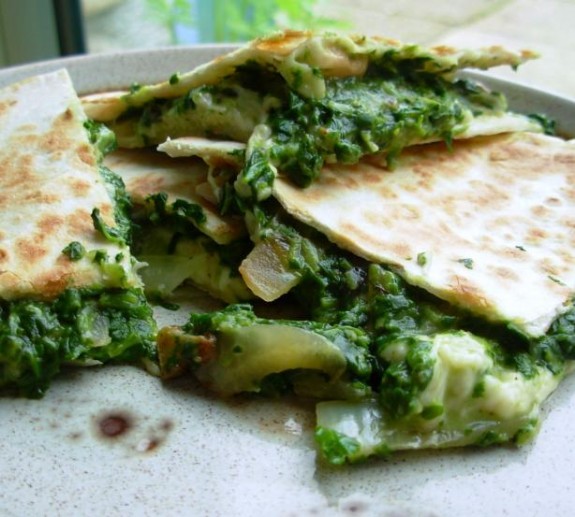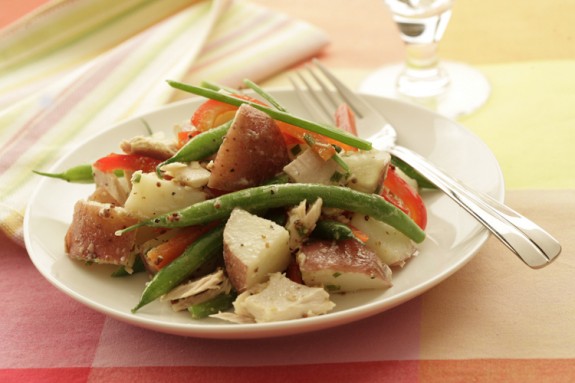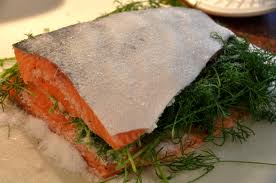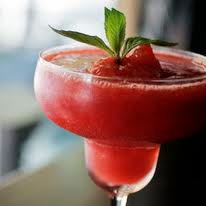Winter Salad of Orange and Pomegranate
- At December 17, 2011
- By Katherine
- In Recipes
 0
0
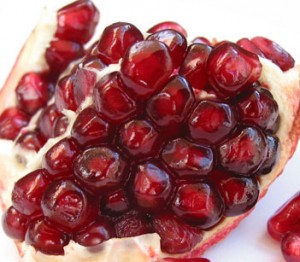 Winter Salad of Orange and Pomegranate
Winter Salad of Orange and Pomegranate
Favorite Holiday Recipes with Love from Katherine
- At December 17, 2011
- By Katherine
- In News, Recipes
 0
0
 Just a Few of Katherine’s Favorite Holiday Recipes
Just a Few of Katherine’s Favorite Holiday Recipes
For weight loss to last, it has to be enjoyable; you cannot feel deprived,” as I say in Diet Simple and try to demonstrate every day with my clients. The food you eat must be delicious, or your healthy lifestyle cannot last. But the holidays, as glorious as they are, bring special health challenges. And I don’t know about you, I do not want to feel stuffed and miserable every day of the holiday season, preferably not even one day (though that might be asking too much!). So not only should your recipes be inviting, and satisfying, it is ideal for as many of them as possible to be light and healthy, too. You’ll have plenty of party food to indulge in, so the food in your home, with a little creativity (and my recipes), could be a rewarding reprieve.
That is why I work so hard to find great recipes for you. I know the holidays are a time when unique, festive menus are important. Here are some of my favorites, recipes I’m repeatedly asked for, which my friends, family, and clients love and are guaranteed to please even the most finicky of foodies, and old fashioned of traditionalists. I promise!
Winter Salad of Orange and Pomegranate
Najmieh’s Yogurt and Spinach Dip
Butternut Squash Soup with Curry and Ginger
Potato Salad with Haricots Verts Smothered in a Lemony Garlic Mayonnaise
Swiss Chard Quesadillas with Chipoltle Salsa
John Ash’s Grandmother’s Pot Roast
Broiled Salmon in a Mustard Seed Crust
Katherine’s Favorite Holiday Cookies
Katherine’s Light Sweet Potato Flan with Vanilla Bean
Dark Chocolate Dipped Pear Slices
There are so many more festive recipes to be found in Diet Simple. Enjoy!
Swiss Chard Quesadillas with Chipoltle Salsa
- At December 17, 2011
- By Katherine
- In Recipes
 0
0
Katherine’s Special Holiday Cookies
- At December 17, 2011
- By Katherine
- In Recipes
 0
0
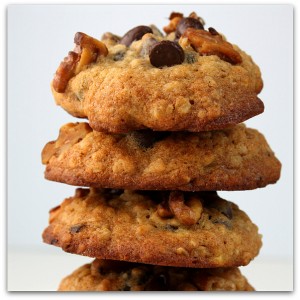 Katherine’s Special Holiday Cookies
Katherine’s Special Holiday Cookies
These are my three favorite cookie recipes. They’re healthier than most, and my clients and friends rave about them. I think you might too! Bake and eat with caution…
Kjerstin’s Swedish Almond Cookies
Makes 24 cookies
Ingredients:
8 1/2- 9 oz almonds
1 1/2 C powdered sugar
2 eggwhites
2-3 drops green food dye (if desired)
Blanch and grind almonds until very fine – like flour. Add sugar, stir in egg whites and mix well.
Make 24 tablespoon-sized round balls and push a piece of slivered blanched almond in the middle
Bake in 350 oven for about 15 – 20 minutes.
* You can buy blanched and slivered almonds in most stores. Some stores even sell almond flour (just make sure it is from whole, pure almonds).
Nutrition Information per cookie: 82 calories, 2.5 grams protein, 5 grams fat, 9.6 grams carbohydrates (0.4 grams saturated fat), 1 gram fiber.
Lighter Chocolate Chip Cookies
Makes 36 -2″ Cookies
Ingredients:
2 Large Eggs
1 Cup Dark Brown Sugar
1/2 Cup White Sugar
1 tsp Vanilla Extract
2 Tbsp Skim Milk
1 Cup Whole Wheat Flour
1 Cup White Flour
1 tsp Baking Soda
1 tsp Salt
1 Package (12 oz) Chocolate Chips
1 Cup Chopped Walnuts, or more to taste (and for increased Omega-6 and Omega-3’s)
Preheat oven to 375F and lightly coat two cookie sheets with vegetable oil spray.
Beat together eggs, brown sugar, white sugar, vanilla, and skim milk until thick and uniformly mixed (do not overmix). Add whole wheat flour, white flour, baking soda, and salt, and beat again until well combined. Add more white flour, a tablespoon at a time, if necessary, beating after each addition, until mixture is no longer wet-looking and is thick enough not to run off the beater when beater is lifted from bowl. Add chocolate chips and nuts and mix until chips and nuts are evenly distributed.
Drop dough onto cookie sheets by teaspoonfuls, leaving about 2 inches between cookies. Bake 8-10 minutes, or until only slightly browned and no longer wet when touched. Cookies will become hard if overbaked, so watch them carefully.
Cool 4 – 5 minutes on cookie sheets, and then transfer to rack.
Each cookie: 108 calories, 4.6 grams fat (1.6 grams saturated fatty Acid, 1.6 grams Omega-6 and Omega-3 Polyunsaturated Fatty Acids), 14 mg Cholesterol, 16 grams carbohydrates, 1.8 grams protein, 91 mg sodium
Katherine’s NOTE:
I’ve mixed chocolate with butterscotch chips, added more nuts (for nut lovers), and even candied cherries. It’s a very versatile recipe…
Chewy Meringue Cookies
Makes 20 cookies
Ingredients:
3 large egg whites
1/2 cup confectioner’s sugar
1 cup chopped dried peaches, apricots or other dried fruit
1 cup sliced almonds or other chopped nuts
1 Tbsp cornstarch
1/4 tsp cinnamon (optional)
1. Preheat oven to 300 degrees. With an electric mixer, beat the egg whites until foamy. Slowly add the sugar until the meringue is thick, glossy and holds soft peaks.
2. In another bowl, mix the dried fruit, nuts, cornstarch and cinnamon. Fold into the meringue.
3. Spoon heaping tablespoon-sized dollops on a greased baking sheet or a sheet lined with parchment paper or a nonstick liner.
4. Bake 35 to 40until they are lightly brown and crisp on the outside.
Nutrition Information per cookie: 51 calories, 1 gram protein, 2.4 grams fat (1.5 grams monounsaturated, 0.6 grams polyunsaturated, 0.2 grams saturated), 11 grams carbohydrate
Katherine’s Note: This recipe has many variations. Instead of one cup of dried fruit, you can use 1/2 fruit and 1/2 chocolate chips or other candies (though that adds to the calories)
Najmieh’s Cauliflower KuKu with Fresh Parsley and Spices
- At October 16, 2011
- By Katherine
- In News, Recipes
 0
0
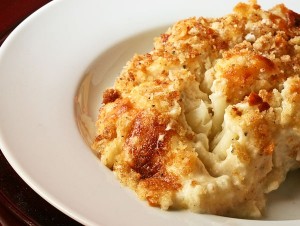 Najmieh’s Cauliflower KuKu with Fresh Parsley and Spices
Najmieh’s Cauliflower KuKu with Fresh Parsley and Spices
A “Kuku” is a Persian mix between a frittata, a type of Spanish omelette, and a souffle. You can use any vegetables and spices, making a delicious and elegant breakfast, lunch or dinner dish. For instance, I’ve used all cauliflower, and I’ve mixed it up with 1/2 cauliflower and 1/2 brussels sprouts, for a change.
Serves 4
Ingredients:
¼ Cup (4 Tablespoons) Canola or Olive Oil
1 Medium Onion, peeled and thinly sliced
2 Cloves Garlic, peeled and thinly sliced
1 Pound Cauliflower Florets, fresh or frozen (1 small head), coarsely chopped
Pinch of Iodized Salt
1/4 teaspoon Freshly Ground Black Pepper
1/2 teaspoon Turmeric
1/4 teaspoon Smoked Paprika
1/4 teaspoon Cayenne
1/2 teaspoon Ground Cumin
4 Eggs
1/2 teaspoon Baking Powder
1 Tablespoon Flour
1/2 teaspoon Iodized Salt
¼ Cup Fresh Parsley, Chopped
4 Sprigs of Parsley for garnish (optional)
Instructions:
Preheat oven to 350 degrees F.
Meanwhile, heat 2 Tablespoons of the oil in a large skillet and brown the onion, garlic and cauliflower over medium high heat for about 15 minutes, stirring occasionally. Stir in the pinch of salt, the pepper, turmeric, smoked paprika, cayenne, and cumin. Let cook on low for another 5 minutes. Cool.
Break eggs into a mixing bowl and add the 1/2 teaspoon of salt, the baking powder, flour, and parsley. Whisk lightly. Add the cooled onion, garlic and cauliflower to the egg mixture and fold with a rubber spatula or large wooden spoon.
Heat the remainder of the oil – 2 Tablespoons – in an 8-inch ovenproof baking dish, such as a round, glass Pyrex dish, by placing it in the oven for 10 minutes, or more. Pour in the egg mixture (it will sizzle) and bake uncovered for 50 to 55 minutes until lightly golden on the top and a “tester” such as a thin knife or metal kabob stick, comes out clean.
Remove from the oven, allow to rest for 5 minutes. Loosen the edges with a thin knife, cover with a serving plate and invert onto the serving plate. Cut into 4 pieces and serve with a sprig of parsley.
Recipe total calories = 900. Divided by 4 servings = 225 calories/serving
“Cauliflower KuKu with Fresh Parsley and Spices” was adapted from Najmieh Batmanglij’s “Food of Life: New Edition” (Mage Publishers, 2011)
Katherine’s Light Sweet Potato Flan with Vanilla Bean
- At October 02, 2011
- By Katherine
- In News, Recipes
 0
0
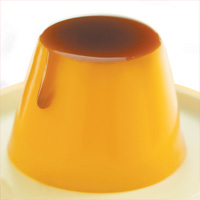 Katherine’s Light Sweet Potato Flan with Vanilla Bean
Katherine’s Light Sweet Potato Flan with Vanilla Bean
By Katherine Tallmadge, MA, RD
A “Flan” is a custard dessert. This one is lighter and simpler than most. Sprinkle with toasted pecans for a bit of crunch. Make in six or eight “personal” soufflé dishes, or in one large dish. Perfect as a holiday dessert, it’s a deliciously fresh stand-in for a Pumpkin or Sweet Potato Pie.
Serves 6 – 8
Unsalted butter or butter spray for the ramekins
2 Cups 1% Lowfat Milk
2/3 cup Granulated Sugar
½ Vanilla Bean, halved lengthwise
¾ pound Sweet Potato (1 large)
2 Eggs
1 Egg Yolk
1 Tablespoon Warm Molasses (Optional)
1 ounce (1/4 cup) Chopped, Toasted Pecans (Optional)
Preheat oven to 350 degrees F. Place sweet potato on the oven rack and let cook for about 45 to 60 minutes or until tender when pierced with a fork. Use long tongs to pull out of the oven. When warm to the touch, remove the peel. Mash the potato flesh and measure out ¾ cup.
Turn oven temperature down to 325 degrees F. Lightly butter or spray the insides of 6 or 8 ½-cup ramekins* or a 6-cup glass Pyrex bowl or soufflé dish.
In a medium saucepan, bring milk, sugar, and vanilla bean slowly to a boil, stirring until sugar is dissolved. Turn off the heat. Pull out the vanilla bean and scrape the vanilla seeds into the milk mixture. Return the pod to the pot and let sit for 15 minutes to let flavors blend.
Meanwhile, puree the 2 eggs and 1 egg yolk with the mashed sweet potato (I use a Cuisinart Smart Stick immersion hand blender). Add the sweet potato mixture to the warm milk mixture and puree until well blended – most easily done (and less messy) with an immersion hand blender. For a smooth custard, try not to create too many bubbles.
Pour the liquid into six or eight ramekins, or into the 6-cup soufflé dish. Set the soufflé dish(es) into a large baking pan and add boiling water until it is halfway up the outsides of the soufflé dish(es). Place in the center of the oven and bake until slightly wobbly in the middle – about 40 to 45 minutes for the individual ramekins or 1 hour if you’re using the larger soufflé dish.
To serve: Leave the custards in the water bath until they are not too hot to handle or until ready to serve. Slide a knife around the inside edge of the individual dishes and turn them onto serving plates. Or scoop out 6 or 8 servings from the large soufflé dish. Over each serving, drizzle the warm molasses and sprinkle chopped, toasted pecans.
*A “ramekin” is an oven-proof ceramic or glass serving dish, usually round, but sometimes in novelty shapes, ie, hearts or ovals.
The entire recipe = 1,000 calories (1,242 calories with molasses and pecans). Divided into 6 servings = 167 calories per serving (207 with molasses and pecans). Eight servings = 125 calories per serving (155 with molasses and pecans).
Katherine’s “Light Sweet Potato Flan with Vanilla Bean” was adapted from award-winning cookbook author, Deborah Madison’s “Local Flavors: Cooking and Eating From America’s Farmers’ Markets.”
Sweet Potatoes, considered one of the “Super Foods,” are loaded with Beta-Carotene, the orange pigment which is a potent anti-oxidant. It is important for your immune system, your skin, your vision, bones, reproduction, and may reduce cancer risk. But sweet potatoes provide so much more; they’re also high in fiber, vitamins C, E, the B vitamins, and minerals such as potassium, manganese, magnesium and iron.
Sweet potatoes’ origins date back thousands of years in Peru, became a favorite of Christopher Columbus once he landed in America, and grow particularly well in the American South, where they have become a staple.
Potato Salad with Haricots Verts Smothered in a Lemony Garlic-Herb Mayonnaise
- At June 29, 2011
- By Katherine
- In Recipes
 2
2
This “salad” can be served warm, for instance, as a side dish for the holidays – with or without the potatoes – or enjoyed cold in the hot summertime weather. The mayonnaise dressing brings out the flavor of any vegetable, especially if allowed to soak into still-warm, just cooked haricots verts (the tender French green bean), delicate, small, thin-skinned “new” potatoes, or broccoli.
Serves 6 to 8
Mayonnaise Dressing:
1/4 Cup Mayonnaise, preferably made with Canola or Olive Oil
Grated Zest and Juice of 1 Lemon
2 Garlic cloves (or more, to taste), mashed
1 Tbsp (or more, to taste) Tarragon or other fresh herb, such as Dill
Salt and Pepper, if desired (no salt needed)
Vegetables:
1 quart Haricots Verts, tough end removed
1 pint small New Potatoes (or any potato), cleaned but not peeled, cut into 1″ pieces
2 Red Bell Peppers, roasted (if desired) and chopped
1 pint cherry tomatoes, sliced in half (and/or any other seasonal vegetables)
1 Bunch (about 4 – 5) Green Onions, chopped
Prepare the dressing in a bowl large enough to fit the salad ingredients by mixing the mayonnaise, the lemon, garlic and fresh herb of your choice. Place in refrigerator to keep chilled.
Steam or boil the haricots verts slightly (in a small amount of water) until they are al dente (firm, but not hard, with resistance to the bite). Drain and immediately place in the bowl of mayonnaise. Toss to coat with mayonnaise dressing. Put the bowl back into the refrigerator to halt the cooking process.
Slice the small potatoes in half or quarters, depending on their size. Boil the potatoes for about 5 or 10 minutes, until tender when pierced by a fork. Drain and place in the bowl with the mayonnaise and haricots vert. Toss to coat with the mayonnaise dressing. Place in the refrigerator.
Roast the red bell peppers if desired, chop, and add to the mix. Chop the white part of the green onions, cut the cherry tomatoes in half, and place in bowl with the other vegetables; toss.
Swedish Gravlax & Mustard Sauce
Gravlax is salmon which is cured, smothered in a dry preparation of salt, pepper, sugar and dill, and refrigerated for a few days. A Scandinavian staple since the middle ages, when it was salted and slightly fermented before refrigeration was invented. It is served with Swedish hard or soft 100% coarse rye bread, on salads, with boiled potatoes, and almost always with plenty of dill and mustard sauce.
2-1/2 pounds fresh salmon (about 1 side of a salmon), cut in half
4 Tbsp Sugar
5 Tbsp Coarse Salt
1 Tbsp White Peppercorns, coarsely ground
1 Bunch Fresh Dill
Lemon and additional dill for garnish
Mix sugar, salt and pepper in a bowl. Set aside.
Place the salmon halves, skin side down, flesh side up, into a shallow baking pan or cutting board. Evenly distribute the sugar, salt, and pepper mixture over both pieces. Place all of the dill on the flesh side of one fish half. Place the other half on top of the first half so that the flesh sides are together, and the thick part of the top half lies on top of the thin part of the bottom half (see photo). Place in the shallow baking pan, and cover with plastic wrap, or into a large plastic bag. Keep in refrigerator for two to three days (at least 24 hours),while flipping every 12 or 24 hours.
To serve, scrape off the marinade, slice fish thinly and roll. Garnish with lemon pieces and dill. Serve with mustard sauce on the side. Serves 8 to 12.
Salmon, high in omega-3-fatty acids, is good for you!
Swedish Mustard Sauce
1-1/2 Tbsp Chopped Fresh Dill
3 Tbsp Gulden’s Mustard
1 Tbsp Sugar
3 to 4 Tbsp Vegetable Oil
All ingredients should be at room temperature. Place mustard in a small bowl, add sugar. Blend in the oil slowly. Add the dill and mix thoroughly.
Salmon, high in omega-3-fatty acids, is good for you!
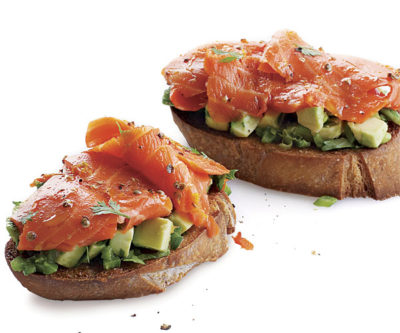
Marcus Samuelsson’s Gravlax Club Sandwich
Two Michelin Star – Aquavit Restaurant
excerpted from “Diet Simple: 195 Mental Tricks, Substitution, Habits & Inspirations”
(LifeLine Press)
This modern version of a gravlax presentation was invented by Chef Marcus Samuelsson, who arguably, made Manhattan’s Two Michelin Star Aquavit first soar the heights of popularity in the 1990’s. The Gravlax Club Sandwich combines the velvety textures of guacamole and gravlax, cured salmon (purchase or see recipe above), with crispy iceberg lettuce (or other greens) and chewy whole grain bread, preferably whole rye. If you want to make this sandwich and don’t happen to have gravlax, substitute smoked salmon for similar success.
I’ve used this recipe at parties. Just cut the sandwiches into smaller appetizer size sandwiches, into quarters, and place a tooth pick through all layers for easy grabbing. It’s always a hit.
Makes 5 sandwiches.
2 avocados
Juice from 2 limes
1/2 medium size red onion, finely chopped
1 medium-size ripe tomato, finely chopped
1 jalapeño pepper, cored, seeded and finely chopped
8 sprigs cilantro, finely chopped
Salt and freshly ground black pepper
10 thin slices of 100% whole grain rye bread, or whole wheat if rye is not available
5 thin slices of Gravlax
1 cup shredded iceberg lettuce (or other greens)
1. Mash the avocado with a fork and add the lime juice. Mix the chopped onion, tomato, jalapeño pepper, and cilantro and toss. Season with salt and freshly ground black pepper to taste.
2. Toast the bread slices lightly and let them cool.
3. Place a slice of gravlax on a slice of bread. Spread 1 to 2 tablespoons of the avocado mixture over the gravlax and sprinkle with shredded iceberg lettuce. Cover with a second slice of bread – or leave open-faced as the Swedes would do. Repeat with the remaining bread slices and gravlax.
1 Gravlax Club Sandwich: Calories 300, Total Fat 15g, Saturated Fat 2g, Cholesterol 5mg, Sodium 740mg, Total Carbohydrate 38g, Dietary Fiber 15g, Omega 3 Fatty Acids 0.82 g, Protein 11g
“MyPlate” Menus Made Easy – and Tasty!
- At June 21, 2011
- By Katherine
- In News, Recipes
 2
2
 From pyramids to plates! Are you confused about what should be on your plate? The Washington Post asked me to design menus based on MyPlate to help clear up some of the confusion. It was so fun for me – and easy, because I had everything I needed already in my book, Diet Simple, where there are tons of menu and recipe ideas which fit perfectly into MyPlate.gov’s scheme. What do you think of MyPlate, The United States Department of Agriculture’s new food plate designed to help Americans make better food choices? Will it help you improve your eating habits? When Bonnie Benwick, reporter for The Washington Post’s “Food” section contacted me and asked me to put together menus based on the My Plate icon and the Dietary Guidelines, I was delighted and up for the challenge.
From pyramids to plates! Are you confused about what should be on your plate? The Washington Post asked me to design menus based on MyPlate to help clear up some of the confusion. It was so fun for me – and easy, because I had everything I needed already in my book, Diet Simple, where there are tons of menu and recipe ideas which fit perfectly into MyPlate.gov’s scheme. What do you think of MyPlate, The United States Department of Agriculture’s new food plate designed to help Americans make better food choices? Will it help you improve your eating habits? When Bonnie Benwick, reporter for The Washington Post’s “Food” section contacted me and asked me to put together menus based on the My Plate icon and the Dietary Guidelines, I was delighted and up for the challenge.
When I create meals and menus I like to keep certain things in mind: number one is TASTE. Your meals must taste good, you have to really enjoy your meals, every bite. They must be interesting, full of flavor, texture, several different food groups and nutrient-dense. I also must keep them SIMPLE. My recipes are simple and quick, and are usually batches which can be eaten for several meals.
BREAKFAST
My breakfast philosophy is that it should contain 1/3 of the daily calories and protein, and contain all four food groups: protein/dairy (in this case, the protein is in the dairy), whole grain (oats, which also lower bad cholesterol), Heart healthy fat (nuts – which lower bad cholesterol and raise good cholesterol), and fruit or vegetable must be at least half of the volume (the dried cranberries, the blueberries and the OJ). I’ve picked very high nutrient and anti-oxidant fruits for this meal. All of the foods are important for the immune system, and building muscle and bone. It’s full of different flavors, textures, a full complement of important nutrients, including fiber. My friends, family, and clients LOVE Katherine’s oatmeal and begin feeling it is their favorite meal of the day. It holds them and prevents that ravenous feeling all day long:
Katherine’s Fabulous Oatmeal (excerpted from “Diet Simple” [June 2011, LifeLine Press])
½ Cup Rolled, Old Fashioned Oats
1 Cup Skim Milk or Soy Milk
1 ounce chopped (one cupped handful), roasted, unsalted almonds, or other nuts
¼ cup Dried Cranberries** or other dried fruit
Place all ingredients in a large glass bowl (need a large bowl as the mixture bubbles up) and into the microwave for 4 – 5 minutes. When finished, let sit in the microwave another minute to let the oats soak up the liquid.
Add:
1 tsp honey/maplesyrup/brown sugar or Splenda for sweetness (optional, to taste)
1 Cup Blueberries or other fruit
Beverages:
½ cup Orange Juice
Green Jasmine Tea (or coffee)
LUNCH
I created a three-course, “sit-down” elegant lunch with a fun-to-eat appetizer which takes time to eat, as you pop the edamame peas into your mouth with your fingers. The main course is a vegan recipe which has been very popular, and takes minutes to make. Then I included more protein/dairy as the dessert, which I think is more creative and fun than drinking a glass of milk. Also, I find when something sweet – even fruit – is part of the meal, people are less likely to crave sweets. We naturally crave all the different flavors and if our meals are too one-dimensional, we start craving the other flavors and are less likely to stick with healthy eating. As MyPlate requires, this meal definitely contains at least half the volume as vegetable/fruit, and vegetarian protein sources: edamame, chick peas, and yogurt, as well as heart healthy fat in the edamame and in the lemon/olive oil vinaigrette for the Chick Pea Salad.
Appetizer: 1 Cup Edamame in pod (boil frozen edamame – soy beans – in their shells for about 10 minutes and pop into your mouth like peanuts)
Main course:Chick Pea Salad with Cumin and Mint
Dessert: Fat Free or Low Fat Fruited yogurt, 1/4 ounce Dark Chocolate Chips mixed in
I recommend iced tea or herbal tea to drink
DINNER
Again, I wanted an enjoyable three course meal starting with an appetizer and ending with a dessert. Very elegant. My dairy/protein is hidden in the delicious dip. At least half the meal is veggies and fruits (the crudités in the appetizer, the spinach placed under the salmon, and the strawberries in the Granita dessert). This is a very nutrient-dense, but low calorie meal, one high in omega-3-fatty acids as well as vitamins, minerals and anti-oxidants. Filled with flavor, texture and colors…
Appetizer: Crudites with Yogurt and Spinach Dip
Main Course: 1 serving Grilled Salmon in a Mustard Crust
Served atop 1 Cup Sauteed Fresh Spinach/Greens, in 1 tsp Extra-Virgin Olive Oil
4 ounces wine, optional (OR a whole grain roll)
Dessert: Strawberry Granita
I love to eat and expect my meals to be delicious. That is true for everyone. What many people don’t realize is that healthy food can also be delicious. I love helping people discover this and seeing the joy in their faces when they realize they don’t have to feel deprived to eat healthy!
Strawberry Granita
- At June 21, 2011
- By Katherine
- In News, Recipes
 0
0
Carole Cutler’s Strawberry Granita
From “Diet Simple: 195 Mental Tricks, Substitutions, Habits & Inspirations”
(June 2011, LifeLine Press)
The best ice cream in the world can be found in Italy, hands down. But much more typical of Italian fare is granita, the wonderfully fresh, flavored ice that is so refreshing after a meal. Here is a granita you can whip up in a flash, and at any time of the year. If using frozen strawberries, the taste says “fresh” thanks to the helpful addition of orange flavoring.
8 servings
Grated peel and Juice of 1 Orange
2 teaspoons orange liqueur (optional)
20 ounces frozen sweetened or fresh strawberries, (and/or raspberries and/or blueberries, if desired and in season)
1 Tablespoon sugar (optional, if using fresh berries)
Optional: 8 mint sprigs
Put eight small sherbet dishes (or martini glasses) in the refrigerator to chill. If using fresh berries, place them (along with the sugar, if desired) in the freezer until frozen. Cut the frozen sweetened or unsweetened berries into large-sized chunks and put into a food processor. Add the orange juice, peel, and liqueur. Pulse for about 30 seconds to break up the chunks, then process on high until the mixture is smooth. When the mixture has been pureed, spoon immediately into the chilled dishes and place in the freezer. If the granita has been frozen for more than six hours, remove it from the freezer 10 minutes before serving time. If desired, decorate with the mint sprigs.
(Muffin cup liners can also be used. Fit each one into a cup in the muffin pan and fill to the 3/4 level, the frozen ice will expand. Place immediately into the freezer.)
For children or the child in YOU, MAKE POPSICLES! Pour the Granita into 8 popsicle molds. Who knew eating healthy could be so delicious and FUN!
Per serving: 80 calories, 0 grams fat, 20 grams carbohydrate, 2 grams fiber, 0 mg sodium, 0 grams protein
Carol Cutler is the award-winning author of eight cookbooks, a syndicated columnist, and restaurant critic. She has often appeared on television cooking shows. She and her journalist husband have traveled extensively, savoring authentic cuisine at its source.
Did you know that there are 200 seeds on each strawberry?
Strawberries are members of the Rose family and there are over 600 different varieties. Choose freshly picked, ripe berries, as they will be the tastiest and will have the most nutrients. “Look for berries fully formed, bright red, without bruising or soft spots and with fresh-looking green caps. Beware of buying out-of-season strawberries, as sometimes they are picked when they are only 40% ripe. These berries may turn red, but they will never develop sweetness,” according to Janie Hibler in “The Berry Bible.”
Strawberries (and other berries) are considered a “superfood.”
They have one of the highest antioxidant and nutrient contents of all foods, yet they are low in calories, so you can eat them in unlimited quantities. In fact, for your health, the more the better! “A serving of eight strawberries contains more vitamin C than an orange. Strawberries are also rich in folate, potassium, and fiber. They’re especially high in cancer- and heart-disease-fighting phytonutrients (beneficial plant compounds) called flavonoids, anthocyanins, ellagic acid, quercetin, catechin, and kaempferol,” according to David Grotto in “101 Foods That Could Save Your Life.”

